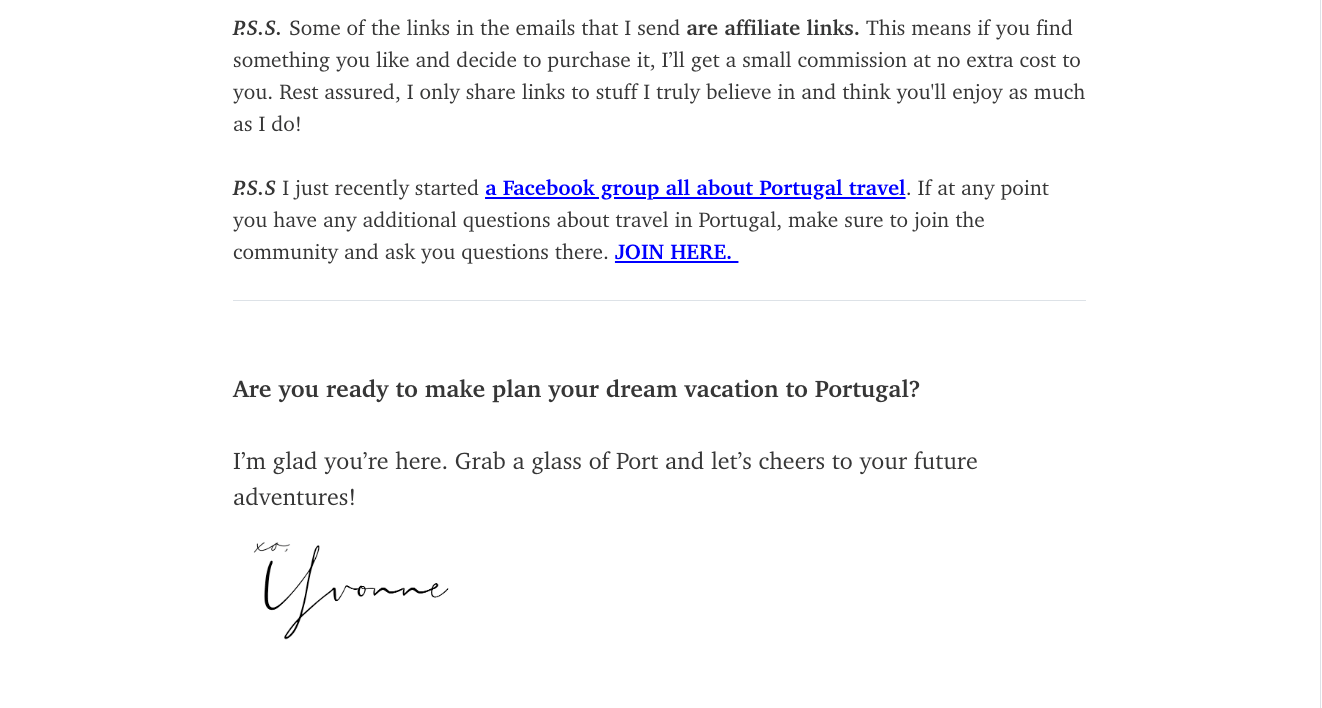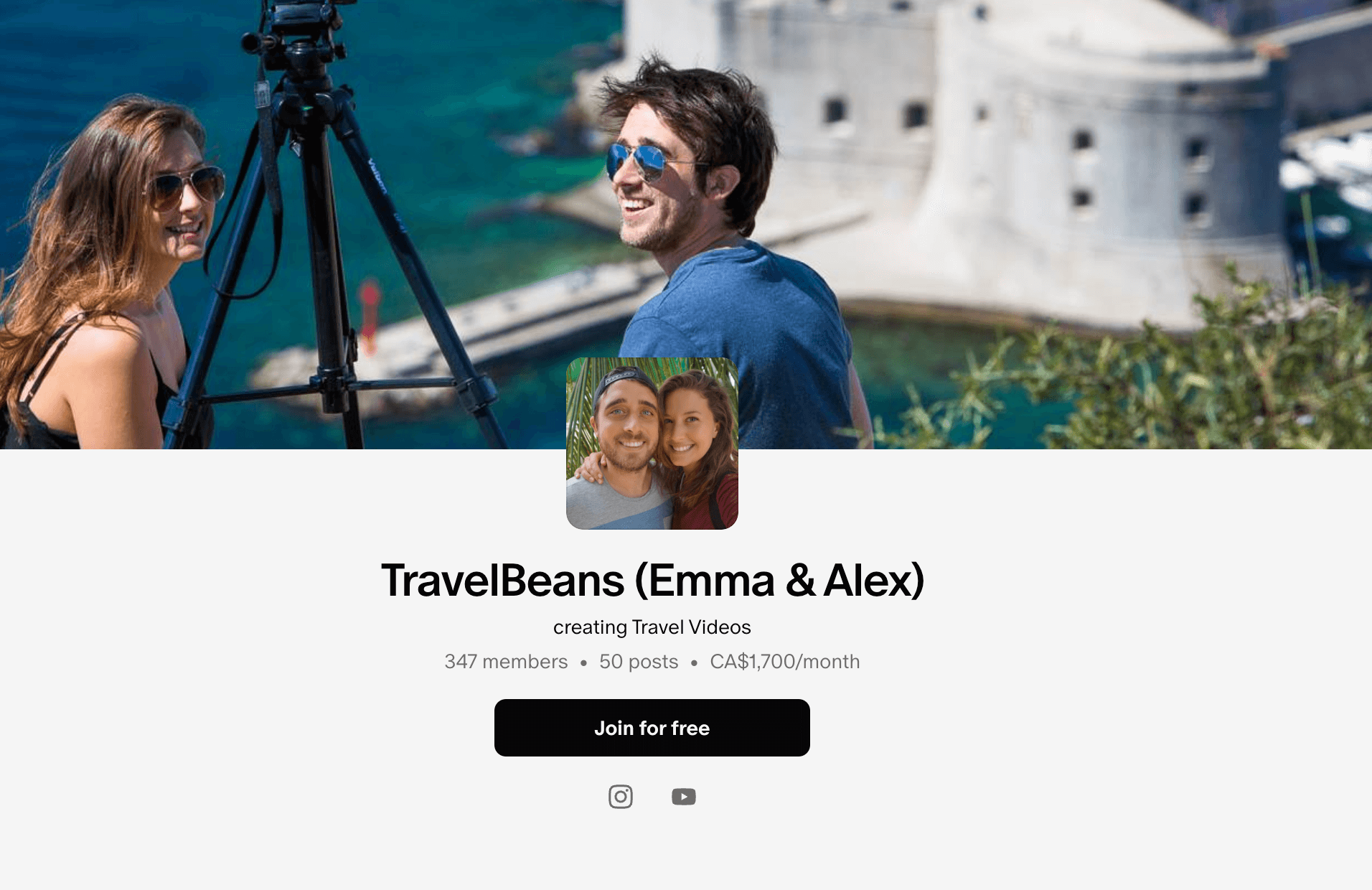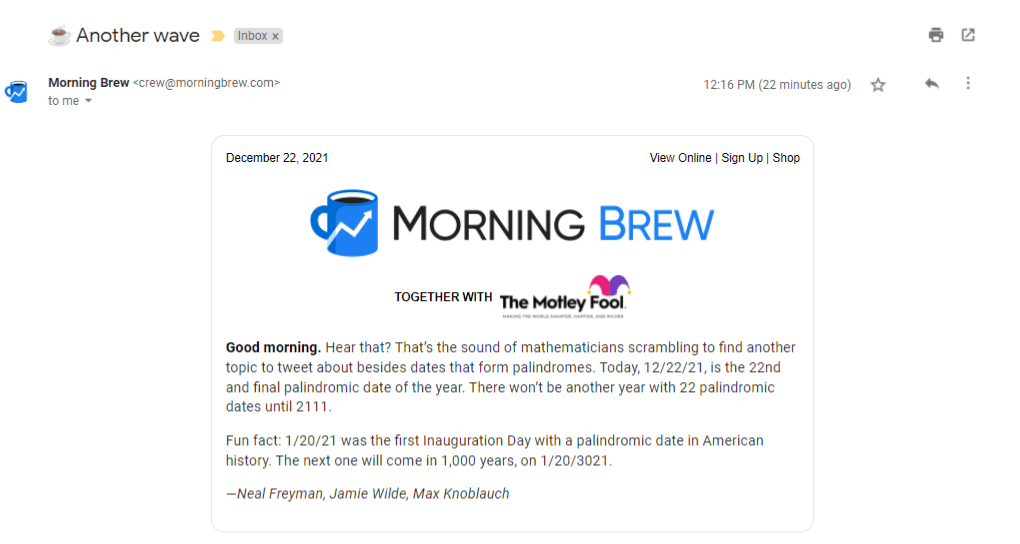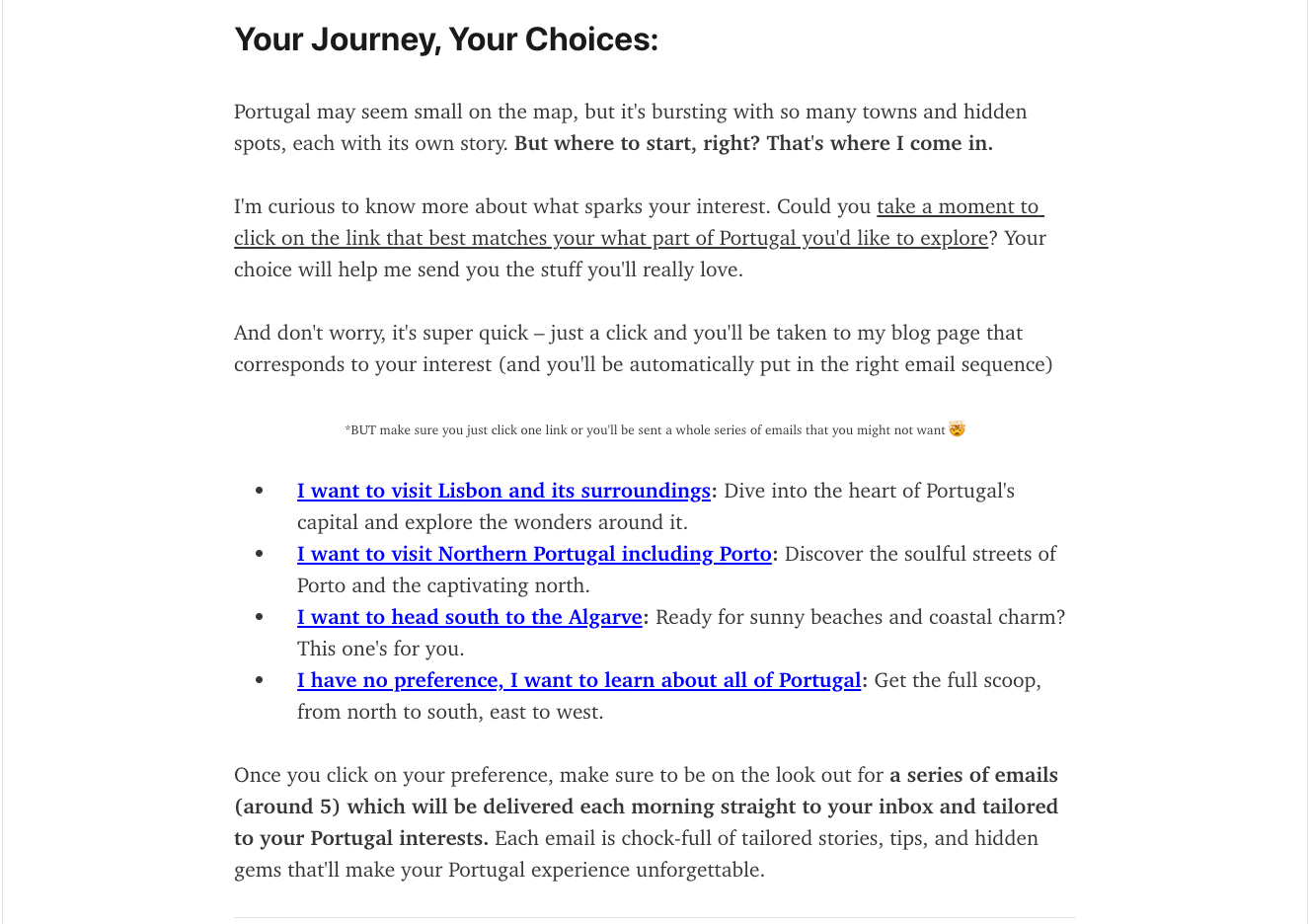We use it every day, multiple times a day, and studies have shown that it has some of the highest ROI of all online channels. Businesses that invest in email marketing generate an average of $36 for every $1 invested.
Now, the caveat? Email marketing is not something you can build overnight, but with consistency, time, and effort, you can create an easily monetizable list.
So, ready to learn how to get paid for your emails? Let’s get into how to make money with email marketing.
1. Affiliate Marketing
One of the easiest ways to earn money with emails is through affiliate marketing. This method involves promoting products or services from companies in exchange for a commission on sales or clicks you generate through affiliate links.
By leveraging the trust you’ve built with your email subscribers, you can recommend travel-related products, accommodations, tours, and insurance that genuinely benefit your readers.
How It Works for Travel Bloggers:
- Sign up for affiliate programs: Join travel-focused affiliate platforms like Travelpayouts, which offers access to multiple travel services from brands. The platform is designed to support travel bloggers by providing you with various affiliate marketing opportunities.
- Integrate affiliate links in your emails: Include links in your email content once you’ve joined relevant affiliate programs. You can incorporate these links naturally, whether sending out travel guides, tips, or destination reviews. For example, if you’re sharing a travel guide to Paris, you can include affiliate links for recommended hotels or tours in Paris.
- Provide value to your subscribers: The key to successful affiliate marketing is offering your subscribers real value. Recommend products and services that you trust and have experience with. Personal recommendations carry more weight and can lead to higher conversion rates.
- Monitor your performance: Use the tools provided by Travelpayouts to track your clicks and conversions. This data will help you understand what resonates with your audience, allowing you to optimize future campaigns.
The key to success with affiliate marketing in travel blogging is to focus on relevance and trust. This trust extends to transparency. Remember to always disclose your affiliate relationships to your subscribers.

Craft your emails to encourage engagement, and always experiment to learn what works and what doesn’t. Not every product will resonate with your audience, so be prepared to experiment with different products, messaging, and email formats to find what works best.
One word of caution: Not all affiliate programs allow email links. A great example is Amazon, whose terms and conditions clearly state that affiliates can not add product links in emails. So make sure to double-check all the terms and conditions of each affiliate program before adding in the link.
2. Paid Memberships/Community
Paid memberships or community platforms are a strategic way for travel bloggers to generate a sustainable income. This method involves creating exclusive content or offering unique experiences only accessible to members who pay a subscription fee.
It’s a model that fosters a closer relationship between bloggers and their most dedicated followers while ensuring a regular income stream.
Creating a paid membership or community involves curating exclusive offerings that resonate with your subscribers’ interests and needs. This could range from advanced travel guides and personalized advice to members-only webinars and special discounts.
The key is to ensure that the content or perks provided are perceived as valuable enough to justify the subscription cost. The best platforms for these membership types include Slack, Patreon, Facebook groups, and Instagram subscription groups.
An example is TravelBeans, founded by Emma and Alex, two travel content creators who create travel videos. In addition to a YouTube channel and an Instagram account, they have created a Patreon page.

Subscribers can choose between three subscription options, which include perks like Patreon-only updates, behind-the-scenes content, and even a personal thank-you video from Alex and Emma.
How does email marketing play a role here? Well, if you already have an email list, use it. Start with a segmented email campaign targeting the most engaged subscribers. These individuals are more likely to see the value in upgrading to a paid subscription.
Highlight the benefits of the membership, such as exclusive content, special offers, and direct access to travel advice, which can make your email list feel more like a VIP club.
For example, a travel blogger could send a series of emails detailing the perks of their membership program, including access to a monthly live webinar discussing travel hacks, a downloadable guide on avoiding tourist traps in popular destinations, or early booking opportunities for group trips organized by the blogger.
3. Advertising & Sponsorships
Advertising and sponsorships involve partnering with brands that identify with your travel-focused content, allowing you to introduce products, services, or experiences through email.
For this to work effectively, having an engaged email list—ideally at least 2,000 email subscribers—is key, as it makes your platform attractive to potential partners.
Sponsored content or advertisements in emails can manifest in various forms, including display ads, which are visually based advertisements like banners or images, and native ads, which are designed to blend seamlessly with the email’s content, offering a less intrusive experience.
Along with different forms, you can take advantage of different types of advertising and sponsorship opportunities.
Solo Ads
Solo ads are a type of email marketing in which a brand pays to send their advertisement (usually promoting a product, service, or event) to another person’s email list.
Essentially, a brand rents your email list with an established subscriber base to directly reach potential customers interested in your niche. This approach can effectively gain targeted exposure and drive traffic to the brand’s offers.
The con? There is a risk that your audience might not like this type of take-over, especially if the brand doesn’t match up with what your subscribers would be interested in. It can also be seen as spammy or less than genuine.
Primary Sponsorship
Primary sponsorship emails, like those labeled brought to you by or sponsored by, involve a single advertiser sponsoring the email content, aligning closely with the sender’s theme or message.
For travel bloggers, this means working with brands directly related to travel, such as gear companies or tourism boards, providing a seamless experience for readers.
Pros include potentially higher revenue from dedicated sponsorships and enhanced trust through relevant partnerships. Cons include the challenge of finding fitting sponsors and the risk of over-commercializing your content, which could turn-off some of your readers.

Secondary Sponsorship
Can also be seen as sponsored content, which typically refers to specific, individual advertisements placed within an email and paid for by advertisers. These can be displayed as either native ads or display ads.
Secondary sponsorships provide a unique space for advertisers and can be quite impactful with the right content and presentation. They are usually positioned in the lower third of the email (but they don’t have to be). Their format may mimic primary sponsorships and might (or might not) include images depending on the newsletter’s style.
The brand or business doesn’t sponsor the entire email, instead, they just buy some space in the email to promote their own products or services.
Text-Only Sponsorships
Text-only sponsorships involve promoting a sponsor’s product or service solely through written content, without visual or multimedia elements such as images, videos, or graphics.
Text-only sponsorships are valued for their ability to deliver targeted messaging in a natural and non-intrusive manner, resonating with audiences who appreciate authentic endorsements within the context of valuable content.
For example, a thoughtfully written paragraph promoting a specific travel product, like a backpack, that you’ve used and loved and now have partnered with the company to promote.
4. Info Products
Knowledge is power. So why don’t you spread that knowledge around a little? Whether in an e-book, webinar, template, or course, you can package and bundle your expertise and sell it to your followers.
Earn money by email by focusing on creating both low-ticket and high-ticket offers to provide more options to your audience. For example, you can include an e-book or a blog post template, like Shelley Marmour, founder of TravelBlogging 101, does, while sprinkling in other higher-end offers like courses.

Achieving success with info products in your email list strategy hinges on creating content that addresses your audience’s specific questions or needs. So, ask your audience for information. What questions do they have? What is it that they need? What are their pain points?
Have conversations with the people who sign up for your email list. Ask for feedback, and if feedback is limited, offer incentives. What kind of incentives? How about early access or bonus features?
The idea is to always be trying to create a genuine relationship and connection between yourself, your brand and your followers.
5. Paid Newsletters
In the realm of travel blogging, paid newsletters offer subscribers exclusive access to insider tips, destination guides, travel hacks, and personalized recommendations for a recurring fee.
Here, you can offer one of two things:
- Completely transform your free newsletter into a paid newsletter
- Supplement your free newsletter with a premium version where you offer exclusive information and tips to paying subscribers.
Paid newsletters work better when they cater to niche interests, such as luxury travel, budget travel, solo travel, or family-friendly destinations, as they provide tailored content for subscribers’ specific needs and preferences.
When creating a paid newsletter, it is important to consider platform fees, especially when determining the price. Some leading platforms and fee structures are:
- Substack: Takes 10% of revenue plus credit card fees.
- ConvertKit: Charges 3.5% plus 30 cents per transaction.
- Ghost: Requires a monthly platform fee and doesn’t charge transaction fees.
Below is an example of a substack newsletter from Kaila Krayewski, a copywriter and Canadian currently living and working abroad in Thailand. She talks about her life abroad and tips and tricks for women who want to live abroad.
You can charge either monthly or annually. You can even add a paired-down free version where people can get a taste of what you will offer in your subscriptions.

6. Consulting & Coaching
Consulting and coaching can be a lucrative avenue for travel bloggers to monetize their expertise. By offering personalized advice, trip planning services, or blogging strategy consultations, you can directly leverage your knowledge and experience to generate income.
This approach allows for deep engagement with your audience and provides them with tailored solutions, enhancing their travel experiences or helping them grow their own travel blogs.

How to monetize email lists has never been easier when you have something unique to offer. Consulting and coaching diversify your revenue streams while adding value to your subscriber base.
7. Tripwire Offers
Tripwire offers are promotions designed to attract customers by offering low-cost initial products or services. These offers act as triggers that lead customers into a sales funnel, where businesses aim to upsell or retain them long-term.
For travel bloggers, it can be as simple as offering an ebook for a discounted price. For example, a detailed, city-specific travel guide could be offered as a low-cost eBook, with a special price of $2.99 for a limited time. Once they have paid, you can upsell. You may have a more extensive ebook, a course, or even travel planning services that you can offer.
Implementing tripwire offers in email marketing involves crafting compelling messages highlighting the offer’s value and potential benefits. Include persuasive call-to-action buttons or links to encourage recipients to take advantage of the offer.
Additionally, segmenting email lists based on customer preferences or behaviors allows for targeted offers that resonate with specific audience segments. How do you segment your audience? Yvonne runs Now in Portugal, a travel website about Portugal. In her introductory email, she allows her audience to self-segment themselves.

Finally, regular follow-up emails can nurture leads and guide them through the sales funnel, ultimately leading to conversions and long-term customer relationships.
8. Email Courses
Email courses are an innovative approach to sharing knowledge and expertise with your audience directly in their inbox. These mini-courses, spanning several days or weeks, cover various topics in digestible segments. You can offer these courses for free, attracting new subscribers and providing valuable content, or as paid offerings, directly monetizing your list.
Below is the example of Sharon Gourlay’s free 7-day link-building challenge, demonstrating the potential of email courses to engage and grow your audience.

9. Getting Traffic Back to Your Website
Last but certainly not least, utilizing your email list to drive traffic (aka people) back to your website is essential for maintaining engagement and promoting your content. You can significantly increase your site’s visitation by strategically including links to your latest blog posts, exclusive deals, or compelling content that requires a visit.
How can you make money with this? Let’s say you have an affiliate marketing blog article that needs a boost in clicks (and sales). You can create an email, directing people to click and read your latest blog post.
Final Thoughts: Make Money With Your Email List
Now that you’ve explored how to make money from an email list, leveraging the right strategies and tools is important. From effective management to choosing suitable software, these elements play a critical role.
It’s about creating a connection that enables you not just to send email earn money but also dive into avenues like how to monetize email lists or monetize email newsletters, ensuring your efforts have positive results.
Engaging with your audience meaningfully can open up opportunities through direct contact or innovative approaches to provide value and try new methods for sustainable success.



